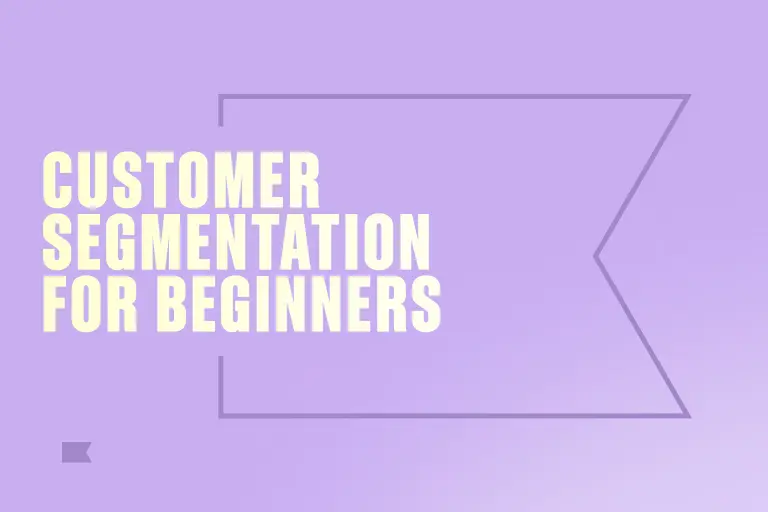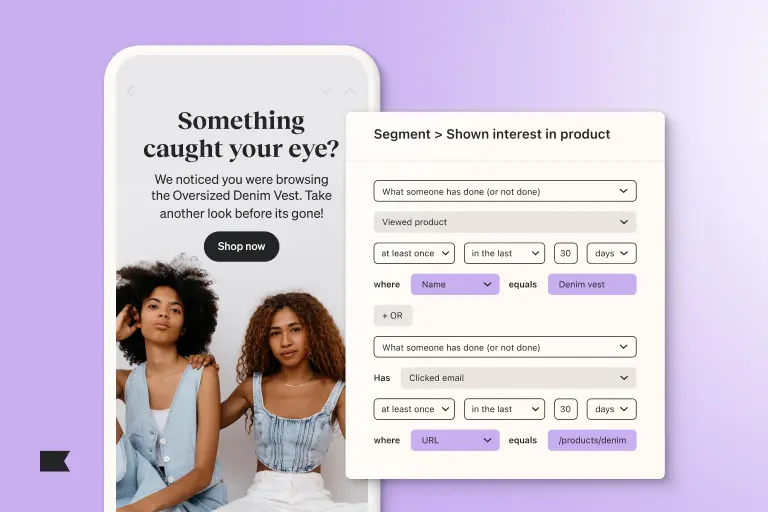Ecommerce personalisation examples & strategies to optimise the customer experience
Consumer data privacy has been in the spotlight for years. For starters, it’s becoming more difficult to target audiences with paid ads online:
- In July 2024, Google announced that they’re rolling out a new Chrome experience that would give people a choice about allowing third-party cookie tracking.
- In late 2023, Apple’s iOS 17 expanded on earlier privacy features by removing link tracking when people are browsing in private mode on Safari or using Apple’s Mail or Messages—though brands can still see who clicked links if they’re UTMs.
- In 2022, Meta removed detailed targeting from its ad service, which ended up increasing competition and pricing out a lot of small to midsize ecommerce businesses.
At the same time, 74% of consumers expect a personalised experience when they engage with brands, according to Klaviyo’s 2025 future of consumer marketing report. It’s just that they want a choice about what they share—33% are willing to share their email address, for example, while only 2% are willing to share their social media information.
As it turns out, what people really want is control—over the personal data they share, how it’s used, and how far it extends.
In other words, people still want to interact with brands, but they want to do it after they’ve given those brands permission to use their data. And that’s a huge opportunity for brands to develop more meaningful—and lucrative—relationships with smaller, more manageable audiences.
If you want this for your own brand, you need to learn about—and invest in—better customer data. Keep reading to find out what that means and how to do it right.
What is ecommerce personalisation?
Ecommerce personalisation is the use of data to tailor both on-site experiences and brand communications—such as personalised emails, SMS, and mobile app messages—for different people based on their demographics, lifestyle factors, and online behaviour.
It’s one thing that can separate an average online shopping experience from an outstanding one.
Here are some types of data you can use to personalise your web on-site experience:
- Zero-party data: information customers voluntarily share with your brand, like email addresses, phone numbers, and preferences shared through surveys or quizzes.
- First-party data: information your brand gets directly through customer interactions in your owned channels, like website behaviour, purchase history, email engagement, and customer service interactions.
- Third-party data: information collected by entities with no direct relationship to your customers, like data brokers, advertising networks, and public records. This type of data is becoming more difficult to use (in part because it’s less desirable for consumers).
“By adding personalisation to your marketing strategy, you make your customers feel like you’re speaking to them directly,” says Gracie Cooper, former digital marketing strategist at Groove Commerce.
Put simply, ecommerce personalisation leads to a better customer experience. It creates customer journeys that feel relevant and timely, whether people are browsing your website or receiving personalised messages. This helps them find and purchase the products they want, faster, ultimately driving higher customer engagement, increased conversions, and stronger customer loyalty.
The benefits of ecommerce personalisation
Ecommerce personalisation has a direct impact on a brand’s bottom line. This is because personalisation—and the segmentation behind it—is the key to creating more relevant marketing campaigns that reach the right audience.
“Creating personalised messages doesn’t have to be a huge lift or require a million different segments,” says Mindy Regnall, head of marketing intelligence at Klaviyo. “If you run a campaign for a big marketing moment, you can break your list into a few segments and change the copy slightly to better reach someone who’s never bought a product before vs. someone who has. The difference can be as simple as ‘try it yourself’ vs. ‘buy it again.’”
Klaviyo’s 2025 benchmark report found that campaign order rates are more than 5x higher for the top 10% of campaigns across both email and SMS. The repeat purchase rate (RPR) is even higher—7x the average.
These top performing campaigns stand out for a few reasons: they��’re highly personalised, more relevant to their audience, and stand out more prominently in inboxes—all factors that lead to improved clicks and conversion rates. In other words, the more targeted your email and SMS campaigns, the higher the potential impact on revenue.
Nonetheless, Jay Narula, head of sales in North America at Nosto, believes both paid ads and paid social will continue to occupy solid places in the business ecosystem for driving traffic. It’s just that these channel investments need to be paired with personalisation efforts to properly pay off.
“Marketers spend an average of $92 to get a paid traffic visitor to a brand’s website, but only $1 to convert them once they’re there,” Narula points out. “The second we shift some of that investment, it pays off 10- and 20-fold.”
“Marketers spend an average of $92 to get a paid traffic visitor to a brand’s website, but only $1 to convert them once they’re there. The second we shift some of that investment, it pays off 10- and 20-fold.“
While personalisation used to be “something nice to have,” he says, “now it’s vital. It used to be a vitamin. Now it’s a painkiller.”
“Nurturing and managing the customer relationships you’re building through website personalisation means converting them vs. not,” Narula adds. “Often 10x, 30x, 80x for brands that really take the time to address it.”
To see the benefits of personalisation—and eventually wean your brand off third-party data—you need to collect high-quality, permission-based data that can tell you more about your customer base than paid channels can. Then you need to use that data to create personalised experiences across all your customer touchpoints.
Data as personalisation fuel: building your unified customer profile
A unified customer profile is a collection of defining characteristics on your customers and subscribers. You’ll be able to create this profile with two types of data:
- Zero-party data: information someone proactively gives to you, like their email address, phone number, or birthday
- First-party data: information you compile from observing your owned channels, like engagement with email marketing campaigns, product page browsing behaviour, and cart abandonment
Mitch McKay, director of partnerships at BigCommerce, prefers this type of data to third-party data because of the consent involved in the process. “I’m willingly giving that to a brand,” he says. “That makes the relationship more enthusiastic, with the potential to be longer-lasting.”
Under this umbrella, the data you collect falls into the following categories:
- Demographic: gender, location, age, income, etc.
- Psychographic: the “why” behind individual customer preferences, such as their likes, dislikes, and values
- Behavioural: past purchases, website browsing history, marketing engagement
- Contextual: devices, channel interactions, seasonal fluctuations
Here are a few of the best ways to collect data for your ecommerce personalisation efforts:
- Klaviyo Customer Hub: When customers log in, you capture both zero party and first-party data, as they interact in the Hub. This allows you to segment better and deliver more personalised experiences across channels.
- Advanced web forms that help you capture more data and self-optimise.
- Quizzes, surveys and conversational SMS: The best ways to collect zero-party data.
- Post-purchase automations, like review requests and custom review questions
- Integrations with your ecommerce site (a gold mine of behavioral data)
- Point-of-sale systems such as Square and Toast (to gather additional behavioral and contextual data).
Okay, but what can you actually do with all that data?
Narula says he sees the most success with real-time behavioural data, which is a direct line into why someone is shopping in your online store. For example, seafood brand Svenfish sends targeted messaging to online shoppers based on their proximity to a newly launched brick-and-mortar shop.
Contextual data is also relevant, Narula adds. These are all data points that can correlate with personalised website content :
- The weather the visitor is experiencing
- The country, state, city, or even neighborhood they’re in
- The time of day
- The device they’re on
- Where they’re coming from—like Facebook, Google, or TikTok
Finally, Narula advocates for session-based data. A trigger or on-the-spot quiz can help a brand personalise an online experience to, say, a woman who’s in her first trimester versus her third.
Once you’ve decided what kinds of data you’ll collect, you need to learn how to use it within your B2C CRM to launch personalised ecommerce site experiences and measure results.
And if you use Klaviyo Customer Hub, you may be able to personalise even faster, with less effort.
“Because so much customer activity feeds straight back into Klaviyo, we’re able to build sharper segments and flows,” says Dan Nikas, founder and director at Elite Brands, an ecommerce marketing agency based in New South Wales, Australia. “If someone adds a product to their wishlist, stalls a return, or updates a subscription, we’ve got data points to act on in real time. That’s gold,” he says.
“Using Customer Hub, we create highly segmented groups based on favorited items,” says Rachel Fagan, VP of marketing at Happy Wax, a natural wax melt brand based in North Carolina. “We trigger automated flows that gently remind customers about products they’ve shown interest in. If they haven’t purchased, we deploy personalised email blocks within broader campaigns that dynamically highlight those specific favorited products.”
What are the main types of ecommerce personalisation?
There are several ways to personalise your brand experience for shoppers, but first it’s critical to understand why 1:1 personalisation is a must-have and the ways you can execute it.
What’s the difference between 1:1 and 1:many personalisation?
1:1 personalisation tailors every single brand interaction with a customer—whether on-site or through messaging—to that customer’s unique preferences and behaviours.
Unlike 1:many personalisation, which groups customers into much broader segments who receive the same content or offers, 1:1 personalisation creates experiences that are truly personal and relevant to each individual. That deeper level of relevance is what ultimately builds trust and loyalty, creating lifetime customers for your brand.
Here are the most effective types of ecommerce personalisation:
| Types of ecommerce personalization | What they do |
| Website personalisation | Appeal more directly to shoppers by featuring relevant products and offers—powered by behavioral data (gathered through shopping behaviors and tactics such as forms). Klaviyo Customer Hub allows customers to log in to instantly experience a highly personalized shopping experience and self-service support, all based on their unique behaviors and needs. With every customer seeing what’s most relevant to them, they’re more likely to buy. |
| Email personalization | Cut through inbox noise and make your brand stand out with personalized product recommendations, dynamic content, or subject lines that hint at their last transaction with your brand. Use the data you have for individual shoppers to create targeted email campaigns that reach them at just the right time and place in the customer journey. Email personalization pro tip: One of the most effective ways to personalize emails is through automations, which send triggered messages such as abandoned cart reminders and post-purchase follow-ups at just the right time. |
| SMS personalization | Use SMS personalization to send sales and offers all based on a customer’s interests and past behavior. Set up automations to send targeted messages such as cart reminders, shipping updates, and re-engagement offers that reflect real actions taken by subscribers and customers. Open the door for real, two-way conversations with SMS, allowing you to answer questions and provide lightning-quick customer service, which humanizes the shopping experience and strengthens customer relationships. |
| Mobile app marketing personalization | Create in-app messages to highlight relevant products or promotions based on each customer’s browsing history and past shopping behaviors. Send relevant offers, reminders, low-inventory alerts, and more via push. These small, personal touches create a helpful, more human experience and keeps your brand top of mind. |
How personalisation can improve the customer experience
show up throughout the entire customer journey. Here’s how personalisation can help during each step:
- Awareness: Use lookalike audiences—people who are similar to your customers—to target specific groups of people who are new to your brand and capture their attention with relevant ads, social content, and emails.
- Consideration: Entice shoppers with personalised product recommendations, content, and offers that match their browsing behaviours.
- Conversion: personalise messages—like abandoned cart reminders and exclusive offers—to convince shoppers to click that buy button.
- Post-purchase: Create thank-you messages, shipping updates, and related product offers, based on items they recently purchased.
- Loyalty: recognise and reward customers with perks, VIP offers, and highly personalised messages to increase repeat purchases and retention.
From the moment a shopper lands on your website to after they join a loyalty program, personalisation can make the experience more relevant and engaging. Here are key some areas where personalisation can enhance the customer experience:
Onsite personalisation with Customer Hub can drive more ‘add to carts’
- Product recommendations based on past purchases and browsing history give shoppers a truly personalised experience.
- Easy access to products they’ve previously browsed means shoppers don’t have to start browsing from scratch.
- You can create content blocks and control which ones are show to certain segments. That means you can tailor messaging for different audiences without redesigning your entire site.
- Unique coupons on shoppers’ “For you” page, so they never have to track down a code they saw elsewhere.
“Customer Hub’s consolidation of personalised recommendations is improving conversion rates for the brands we work with,” says Justin Ragsdale, strategy consultant at IM Digital, a leading digital advisory firm and Shopify Premium Partner.
This kind of service makes it easier for people to find what they’re looking for, which can decrease bounce rates and increase conversions.
Next steps: gather the data you need to execute these tactics
Klaviyo B2C CRM centralises subscriber and customer data within a platform that also brings together your marketing, service, and analytics.
When you only need one piece of software to gather data and use that data, the personalisation tactics we’ve highlighted here are a lot easier to execute.
Ecommerce personalisation FAQs
Why is ecommerce personalisation important?
Ecommerce personalisation is important because it creates a better customer experience. Personalisation can help people find and purchase the products they want quickly, reducing frustration and increasing satisfaction.
Personalisation also improves website, email, SMS, and mobile app engagement, boosts conversion rates, and fosters customer loyalty by delivering tailored recommendations, dynamic content, and seamless interactions. When shoppers feel understood and valued, they’re more likely to return, ultimately driving higher sales and long-term business growth.
What is the difference between personalisation and customisation?
Personalisation is when a brand tailors content, recommendations, or experiences to a customer based on data such as browsing behaviour, purchase history, or demographics. It happens automatically, without requiring the customer to make adjustments.
Customisation, on the other hand, is when the customer actively modifies their own experience. They may select product features, adjust settings, or choose preferences.
How can I measure the effectiveness of ecommerce personalisation efforts?
You can measure the effectiveness of ecommerce personalisation efforts by A/B testing them on your website and in the messages you send. Start by implementing something simple, like a first name populated in a form, and measuring click and conversion rates on that asset. When you have a solid amount of data, try implementing more personalisation across your site and in your messages to increase conversions.
What technologies are used for ecommerce personalisation?
Ecommerce personalisation relies on a combination of advanced technologies to tailor shopping experiences based on customer data. Key technologies include:
- Artificial intelligence and machine learning: These analyse customer behaviour and predict preferences to deliver personalised recommendations.
- B2C CRMs: CRMs centralise customer data from multiple sources, allowing businesses to create unified customer profiles for targeted personalisation. Platforms like Klaviyo combine their CRM with marketing automation to help brands deliver personalised emails, SMS, and other communications based on behaviour and segmentation.
- Behavioural tracking tools: Website analytics and heatmaps track user interactions, helping brands optimise personalised experiences.
- Dynamic content engines: These adjust website elements in real time, such as personalised banners, product recommendations, and email content.
- Recommendation engines: AI-driven algorithms suggest products based on past purchases, browsing history, or similar customer behaviour.
- Chatbots and virtual assistants: AI-powered chatbots provide personalised shopping assistance and customer support.
By integrating these technologies, ecommerce brands can create omnichannel, data-driven personalisation strategies that enhance customer engagement and drive conversions.
What are the challenges of implementing ecommerce personalisation?
Ecommerce personalisation comes with some challenges if you don’t have the data infrastructure to collect and analyse customer behaviour. As an added layer, you’ll also need the right marketing integrations to translate that data into a personalised experience on your website and in the messages you send.
What is Klaviyo Customer Hub?
Klaviyo Customer Hub is a one-stop shop for your customers to:
- Manage their account
- Track orders
- View favorites
- Get support
- See personalised recommendations
These features are ready-made and integrate with your omnichannel marketing stack easily.

Related content

Learn how to use Klaviyo data to improve personalisation, enhance customer journeys, and boost engagement for long-term retention.

Learn about customer segmentation examples that can boost your marketing strategy, improve engagement, and drive revenue.

Imagine walking into a coffee shop for the first time. The barista greets you with a warm smile, ready to suggest a popular drink or offer a sample of a delicious pastry. Their friendly approach makes you feel welcome and helps you feel more comfortable in a new environment. Now imagine you’re a regular. The […]